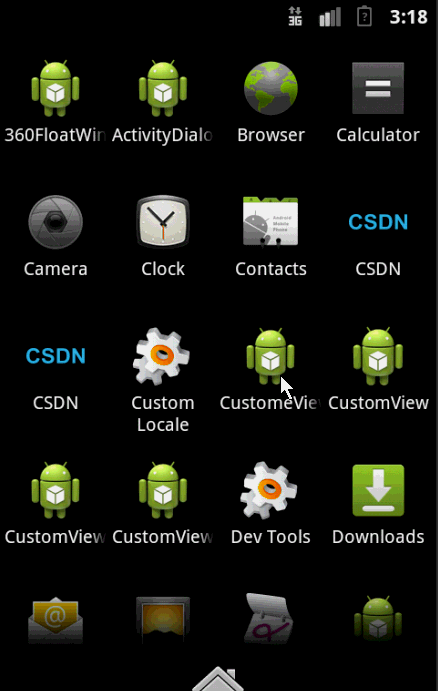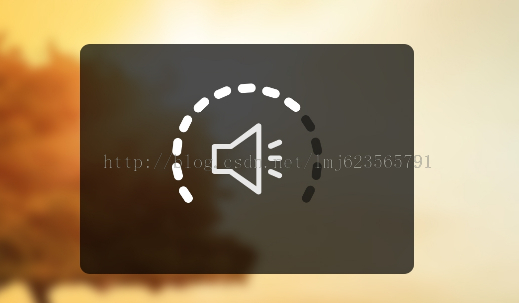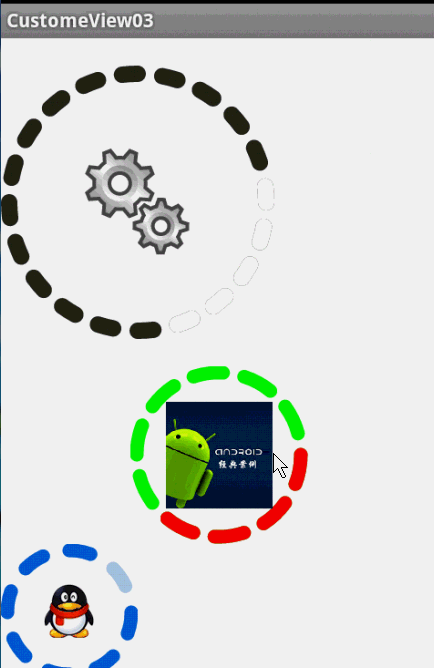
- android ListView深入理解
- Android开发实现TextView显示丰富的文本
- 利用smsmanager实现后台发送短信示例
- 解析android中系统日期时间的获取
- Android 简单的照相机程序的实例代码
- android 放大镜ShapeDrawable妙用分享
- Android自定义View仿QQ健康界面
- Android开发之ImageLoader本地缓存
- android实现静默安装与卸载的方法
- Android实现粒子爆炸效果的方法
- Android App中的GridView网格布局使用指南
- [Android开发视频教学]01_04_Activity初步
- Android App中使用ViewPager+Fragment实现滑动切换效果
- 详解Android Activity之间切换传递数据的方法
- Android自定义ProgressDialog加载图片
- Android中使用Toast.cancel()方法优化toast内容显示的解决方法
- 深入理解Android中的Handler异步通信机制
- Android开发笔记之图片缓存、手势及OOM分析
- Android SQLite详解及示例代码
- android开发之横向滚动/竖向滚动的ListView(固定列头)
- Android开发自学笔记(四):APP布局下
- Android 按指定大小读取图片的实例
- Android读取用户号码,手机串号,SIM卡序列号的实现代码
- android监听安装和卸载示例
- 移动端WebApp隐藏地址栏的方法
- mac开发android环境搭建步骤图解
- Android ListView的item背景色设置和item点击无响应的解决方法
- Android中获取电池电量实例代码
- [Android开发从零开始].25.数据存储(4)
- Android入门之TabHost与TabWidget实例解析
Android中自定义View实现圆环等待及相关的音量调节效果
作者:佚名 Android开发编辑:admin 更新时间:2022-07-23
圆环交替、等待效果

效果就这样,分析了一下,大概有这几个属性,两个颜色,一个速度,一个圆环的宽度。
自定View的几个步骤:
1、自定义View的属性
2、在View的构造方法中获得我们自定义的属性
3、重写onMesure
4、重写onDraw
1、自定义属性:
<?xml version="1.0" encoding="utf-8"?>
<resources>
<attr name="firstColor" format="color" />
<attr name="secondColor" format="color" />
<attr name="circleWidth" format="dimension" />
<attr name="speed" format="integer" />
<declare-styleable name="CustomProgressBar">
<attr name="firstColor" />
<attr name="secondColor" />
<attr name="circleWidth" />
<attr name="speed" />
</declare-styleable>
</resources>
2、在View的构造方法中获得我们自定义的属性
/**
* 第一圈的颜色
*/
private int mFirstColor;
/**
* 第二圈的颜色
*/
private int mSecondColor;
/**
* 圈的宽度
*/
private int mCircleWidth;
/**
* 画笔
*/
private Paint mPaint;
/**
* 当前进度
*/
private int mProgress;
/**
* 速度
*/
private int mSpeed;
/**
* 是否应该开始下一个
*/
private boolean isNext = false;
public CustomProgressBar(Context context, AttributeSet attrs)
{
this(context, attrs, 0);
}
public CustomProgressBar(Context context)
{
this(context, null);
}
/**
* 必要的初始化,获得一些自定义的值
*
* @param context
* @param attrs
* @param defStyle
*/
public CustomProgressBar(Context context, AttributeSet attrs, int defStyle)
{
super(context, attrs, defStyle);
TypedArray a = context.getTheme().obtainStyledAttributes(attrs, R.styleable.CustomProgressBar, defStyle, 0);
int n = a.getIndexCount();
for (int i = 0; i < n; i++)
{
int attr = a.getIndex(i);
switch (attr)
{
case R.styleable.CustomProgressBar_firstColor:
mFirstColor = a.getColor(attr, Color.GREEN);
break;
case R.styleable.CustomProgressBar_secondColor:
mSecondColor = a.getColor(attr, Color.RED);
break;
case R.styleable.CustomProgressBar_circleWidth:
mCircleWidth = a.getDimensionPixelSize(attr, (int) TypedValue.applyDimension(
TypedValue.COMPLEX_UNIT_PX, 20, getResources().getDisplayMetrics()));
break;
case R.styleable.CustomProgressBar_speed:
mSpeed = a.getInt(attr, 20);// 默认20
break;
}
}
a.recycle();
mPaint = new Paint();
// 绘图线程
new Thread()
{
public void run()
{
while (true)
{
mProgress++;
if (mProgress == 360)
{
mProgress = 0;
if (!isNext)
isNext = true;
else
isNext = false;
}
postInvalidate();
try
{
Thread.sleep(mSpeed);
} catch (InterruptedException e)
{
e.printStackTrace();
}
}
};
}.start();
}
3、直接重写onDraw,这不需要重写onMeasure
@Override
protected void onDraw(Canvas canvas)
{
int centre = getWidth() / 2; // 获取圆心的x坐标
int radius = centre - mCircleWidth / 2;// 半径
mPaint.setStrokeWidth(mCircleWidth); // 设置圆环的宽度
mPaint.setAntiAlias(true); // 消除锯齿
mPaint.setStyle(Paint.Style.STROKE); // 设置空心
RectF oval = new RectF(centre - radius, centre - radius, centre + radius, centre + radius); // 用于定义的圆弧的形状和大小的界限
if (!isNext)
{// 第一颜色的圈完整,第二颜色跑
mPaint.setColor(mFirstColor); // 设置圆环的颜色
canvas.drawCircle(centre, centre, radius, mPaint); // 画出圆环
mPaint.setColor(mSecondColor); // 设置圆环的颜色
canvas.drawArc(oval, -90, mProgress, false, mPaint); // 根据进度画圆弧
} else
{
mPaint.setColor(mSecondColor); // 设置圆环的颜色
canvas.drawCircle(centre, centre, radius, mPaint); // 画出圆环
mPaint.setColor(mFirstColor); // 设置圆环的颜色
canvas.drawArc(oval, -90, mProgress, false, mPaint); // 根据进度画圆弧
}
}
大功完成了,当然了,唯一比较纠结的地方就是两个颜色何时切换,如何切换,我采用上面的办法,你也可以自己想想怎么实现。
视频音量调控

这样一个效果使用自定义View来实现的话和圆环的思路差不多,所以我们一起来看:
1、先分许需要的属性,两个小块的颜色、一张中间的图片、间隙大小、一个多少个块块。分析完毕,开始写attr.xml
<?xml version="1.0" encoding="utf-8"?>
<resources>
<attr name="firstColor" format="color" />
<attr name="secondColor" format="color" />
<attr name="circleWidth" format="dimension" />
<attr name="dotCount" format="integer" />
<attr name="splitSize" format="integer" />
<attr name="bg" format="reference"></attr>
<declare-styleable name="CustomVolumControlBar">
<attr name="firstColor" />
<attr name="secondColor" />
<attr name="circleWidth" />
<attr name="dotCount" />
<attr name="splitSize" />
<attr name="bg" />
</declare-styleable>
</resources>
2、在构造中获取这些属性:
/**
* 第一圈的颜色
*/
private int mFirstColor;
/**
* 第二圈的颜色
*/
private int mSecondColor;
/**
* 圈的宽度
*/
private int mCircleWidth;
/**
* 画笔
*/
private Paint mPaint;
/**
* 当前进度
*/
private int mCurrentCount = 3;
/**
* 中间的图片
*/
private Bitmap mImage;
/**
* 每个块块间的间隙
*/
private int mSplitSize;
/**
* 个数
*/
private int mCount;
private Rect mRect;
public CustomVolumControlBar(Context context, AttributeSet attrs)
{
this(context, attrs, 0);
}
public CustomVolumControlBar(Context context)
{
this(context, null);
}
/**
* 必要的初始化,获得一些自定义的值
*
* @param context
* @param attrs
* @param defStyle
*/
public CustomVolumControlBar(Context context, AttributeSet attrs, int defStyle)
{
super(context, attrs, defStyle);
TypedArray a = context.getTheme().obtainStyledAttributes(attrs, R.styleable.CustomVolumControlBar, defStyle, 0);
int n = a.getIndexCount();
for (int i = 0; i < n; i++)
{
int attr = a.getIndex(i);
switch (attr)
{
case R.styleable.CustomVolumControlBar_firstColor:
mFirstColor = a.getColor(attr, Color.GREEN);
break;
case R.styleable.CustomVolumControlBar_secondColor:
mSecondColor = a.getColor(attr, Color.CYAN);
break;
case R.styleable.CustomVolumControlBar_bg:
mImage = BitmapFactory.decodeResource(getResources(), a.getResourceId(attr, 0));
break;
case R.styleable.CustomVolumControlBar_circleWidth:
mCircleWidth = a.getDimensionPixelSize(attr, (int) TypedValue.applyDimension(
TypedValue.COMPLEX_UNIT_PX, 20, getResources().getDisplayMetrics()));
break;
case R.styleable.CustomVolumControlBar_dotCount:
mCount = a.getInt(attr, 20);// 默认20
break;
case R.styleable.CustomVolumControlBar_splitSize:
mSplitSize = a.getInt(attr, 20);
break;
}
}
a.recycle();
mPaint = new Paint();
mRect = new Rect();
}
3、重写onDraw
@Override
protected void onDraw(Canvas canvas)
{
mPaint.setAntiAlias(true); // 消除锯齿
mPaint.setStrokeWidth(mCircleWidth); // 设置圆环的宽度
mPaint.setStrokeCap(Paint.Cap.ROUND); // 定义线段断电形状为圆头
mPaint.setAntiAlias(true); // 消除锯齿
mPaint.setStyle(Paint.Style.STROKE); // 设置空心
int centre = getWidth() / 2; // 获取圆心的x坐标
int radius = centre - mCircleWidth / 2;// 半径
/**
* 画块块去
*/
drawOval(canvas, centre, radius);
/**
* 计算内切正方形的位置
*/
int relRadius = radius - mCircleWidth / 2;// 获得内圆的半径
/**
* 内切正方形的距离顶部 = mCircleWidth + relRadius - √2 / 2
*/
mRect.left = (int) (relRadius - Math.sqrt(2) * 1.0f / 2 * relRadius) + mCircleWidth;
/**
* 内切正方形的距离左边 = mCircleWidth + relRadius - √2 / 2
*/
mRect.top = (int) (relRadius - Math.sqrt(2) * 1.0f / 2 * relRadius) + mCircleWidth;
mRect.bottom = (int) (mRect.left + Math.sqrt(2) * relRadius);
mRect.right = (int) (mRect.left + Math.sqrt(2) * relRadius);
/**
* 如果图片比较小,那么根据图片的尺寸放置到正中心
*/
if (mImage.getWidth() < Math.sqrt(2) * relRadius)
{
mRect.left = (int) (mRect.left + Math.sqrt(2) * relRadius * 1.0f / 2 - mImage.getWidth() * 1.0f / 2);
mRect.top = (int) (mRect.top + Math.sqrt(2) * relRadius * 1.0f / 2 - mImage.getHeight() * 1.0f / 2);
mRect.right = (int) (mRect.left + mImage.getWidth());
mRect.bottom = (int) (mRect.top + mImage.getHeight());
}
// 绘图
canvas.drawBitmap(mImage, null, mRect, mPaint);
}
/**
* 根据参数画出每个小块
*
* @param canvas
* @param centre
* @param radius
*/
private void drawOval(Canvas canvas, int centre, int radius)
{
/**
* 根据需要画的个数以及间隙计算每个块块所占的比例*360
*/
float itemSize = (360 * 1.0f - mCount * mSplitSize) / mCount;
RectF oval = new RectF(centre - radius, centre - radius, centre + radius, centre + radius); // 用于定义的圆弧的形状和大小的界限
mPaint.setColor(mFirstColor); // 设置圆环的颜色
for (int i = 0; i < mCount; i++)
{
canvas.drawArc(oval, i * (itemSize + mSplitSize), itemSize, false, mPaint); // 根据进度画圆弧
}
mPaint.setColor(mSecondColor); // 设置圆环的颜色
for (int i = 0; i < mCurrentCount; i++)
{
canvas.drawArc(oval, i * (itemSize + mSplitSize), itemSize, false, mPaint); // 根据进度画圆弧
}
}
这里需要注意下:
画块:首先根据块数量和间隙计算,每个块所占的比例。
画图:当图比较大时,直接使用该环内切正方形大小进行约束,当图片比较小时,在正中心的位置绘制。有些数学运算过程,楼主在草稿上画了一会,不复杂,大家自己画画,我就不贴草稿了。
4、添加触摸监听:
/**
* 当前数量+1
*/
public void up()
{
mCurrentCount++;
postInvalidate();
}
/**
* 当前数量-1
*/
public void down()
{
mCurrentCount--;
postInvalidate();
}
private int xDown, xUp;
@Override
public boolean onTouchEvent(MotionEvent event)
{
switch (event.getAction())
{
case MotionEvent.ACTION_DOWN:
xDown = (int) event.getY();
break;
case MotionEvent.ACTION_UP:
xUp = (int) event.getY();
if (xUp > xDown)// 下滑
{
down();
} else
{
up();
}
break;
}
return true;
}
触摸监听也得很简单哈,基本能实现,大家也可以加个最小距离加速度什么的,都行。
最后,效果图:

- 上一篇文章: Android应用中实现手势控制图片缩放的完全攻略
- 下一篇文章: Android应用开发中自定义ViewGroup视图容器的教程
- Android中日期与时间设置控件用法实例
- Android中Textview超链接实现方式
- Android实现定制返回按钮动画效果的方法
- android 图片操作(缩放移动) 实例代码
- android中Bitmap用法(显示,保存,缩放,旋转)
- Android中常用的XML生成方法实例分析
- 使用RecyclerView添加Header和Footer的方法